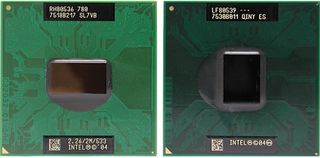Will Core Duo Notebooks Trade Battery Life For Quicker Response?
Yonah: Pentium M Successor With Two Cores

65 nm manufacturing makes it possible: Yonah has two cores and noticeably more transistors, but the die is barely larger than that of a Dothan processor.
Like the current desktop dual core models in the Pentium D 900 series, Yonah technology is based on the 65 nm fabrication process. Among other things, when compared to the preceding Dothan models, this die shrink enables placing more transistors into the same surface area. This helps reduce some production costs, because more CPU dies can be engraved onto a single wafer than would have been possible with older process technology.
Together, both of Yonah's cores consume a surface area of only 90.3 mm2, including a 2 MB L2 cache, with a total transistor count of 151 million. The die is only slightly larger than the preceding single core Dothan, which included approximately 140 million transistors on a surface area of 83.6 mm2.
Still, one shouldn't overlook that more than 90 percent of Dothan's transistors went into its L2 cache alone. Had Intel's Yonah or the Pentium D 800 desktop models been constructed using 90 nm technology, not only would the 2 MB L2 cache have been about 40 percent larger, but both of the processor cores would have been bigger as well. This would also have entailed power consumption levels high enough to make their use in a mobile PC difficult, if not impossible. The use of 65 nm technology makes it possible to fabricate a dual core processor whose theoretical maximum power consumption is 31 Watts, only 4 Watts higher than the Pentium M 780's at 27 Watts.

Despite identical pin counts, Dothan and Yonah are not pin-compatible.
Stay on the Cutting Edge
Join the experts who read Tom's Hardware for the inside track on enthusiast PC tech news — and have for over 25 years. We'll send breaking news and in-depth reviews of CPUs, GPUs, AI, maker hardware and more straight to your inbox.
Current page: Yonah: Pentium M Successor With Two Cores
Prev Page Is Faster Notebook Performance Worth Shorter Battery Life? Next Page ..., Faster Front Side Bus (FSB),Most Popular

